| Diseño práctico y INSTALACIÓN |
| |
|
| 4.1 |
Una bomba sumergible portátil debe ser proporcionada con el fin de permitir flexibilidad en la operación. Esta bomba se puede utilizar para reciclar el efluente de la planta para mantener el STP en una condición de trabajo cuando el flujo entrante es baja. |
| |
|
| 4.2 |
Un espacio para la cabeza general de 3 m se debe mantener para STP cerrado o subterráneo con ventilación artificial. Esto puede reducirse a 2,5 m en puntos localizados, por ejemplo, bajo las vigas. |
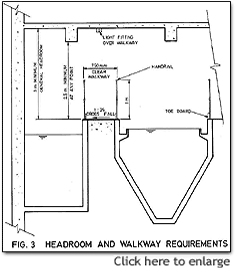 |
| |
|
| 4.3 |
Para STP cerrado, un volumen de aire mínimo de 14 m 3 debe ser proporcionada. La ventilación artificial debe estar provisto de no menos de 10 cambios de aire por hora. Tubos de ventilación de escape deben llevarse hasta una altura no inferior a 1 m por encima del techo del edificio en la que se encuentra el STP. |
|
| |
|
| 4.4 |
pasarelas de acceso de mínima anchura libre de 0,75 m deben mantenerse dentro de la STP para el acceso a todas las áreas que requieren mantenimiento y operación. Pasarelas debe tener carriles de seguridad (preferentemente acero inoxidable) y rodapiés. Pasarelas se debe colocar a una pendiente transversal 1:25 para evitar ponding si de construcción sólida y que no debe ser obstruida por el cruce de tuberías. |
| |
|
| 4.5 |
Cuando los niveles varían, escaleras deben ser proporcionados y no catladders o planchas de paso. |
| |
|
| 4.6 |
Todos los tanques deben estar provistos de escalera o plancha de acero inoxidable para el acceso. El acero dulce no debe ser utilizado. hierros paso debe estar espaciadas a 300 mm c / c horizontalmente y 250 mm c / c verticalmente. |
| |
|
| 4.7 |
Si un tanque tiene que ser cubierta, acero inoxidable o suelo de malla abierta de aleación de aluminio se deben utilizar (aluminio no debe sin embargo ser utilizada en instalaciones de cloración ubicadas en espacio confinado). suelos de malla abierta debe ser diseñado para 5 kPa carga uniformemente distribuida. |
| |
|
| 4.8 |
Provisión de una emergencia de by-pass a la STP no se permite en circunstancias normales. |
| |
|
| 4.9 |
grifos de agua frescos para las mangueras y el lavado de manos deben proporcionarse en el STP en lugares convenientes y deben ser mostrados en los dibujos. |
| |
|
| 4.10 |
Electrical distribution boards and control panels should be installed in locations not liable to flooding and the locations shall be shown in the drawings. Panels should have a dehumidifying heater. |
| |
|
| 4.11 |
The control panel should incorporate a mimic/schematic diagram and all labels should be in both English and Chinese. All values, penstocks, pumps etc. should be appropriately labelled. |
| |
|
| 4.12 |
Hours run meters should be provided for all major equipment to record the total hours of operation. They should be of the non-resettable type. |
| |
|
| 4.13 |
Coarse screens should be provided to precede pumps. Fine screens should be placed downstream of equalization tanks equipped with air ejectors so as to minimize organic solids content in the screenings. |
| |
|
| 4.14 |
Mechanical screens should be the static type or of the type having the rakes moving in the bar openings and not on the bar. Either manual or mechanical by-pass screens should always be provided. The duty screen channel should have a high level overflow into the standby screen channel so that the flow diverts automatically through the standby screen in case the duty one is blocked. |
| |
|
| 4.15 |
Excessive screen channel width which results in shallow depth of flow should be avoided. In case of small developments where the smallest mechanical screen commercially available is still too wide, a manual screen may be used. Bars of screen should be extended to the invert of the channel. For manual screens, consideration should be given to:
- access by operator;
- ease of removal of screenings by operator, including provision of suitable rake;
- draining of screenings;
- bagging and storage of screenings.
|
| |
|
| 4.16 |
A perforated/mesh type drain tray (of stainless steel or plastic material) should be provided to allow the screenings to drain prior to packaging. |
| |
|
| 4.17 |
Pump sumps (including equalization tanks) should be designed to limit the pump starts to not more than 10 times/hour. |
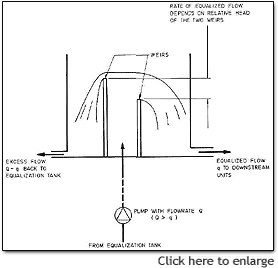 |
| |
|
| 4.18 |
Electrical voltage for level sensors in pump sumps should not exceed 24 V to avoid electrical hazard. |
| |
|
| 4.19 |
High level alarms should be provided in all pump sumps. This should be in the form of visual and audio alarms connected to a suitable constantly manned location. |
|
| |
|
| 4.20 |
Pumps should be carefully chosen to correspond to the design duty point. Flow regulation tanks with control weir should be used if only bigger pumps are available. |
| |
|
| 4.21 |
Comminutors, especially the enclosed type, are discouraged as they often cause operational problems in the STP. |
| |
|
| 4.22 |
Sedimentation tanks should be designed either as rectangular horizontal flow tank, or as square/circular upward flow tank. For horizontal flow tank, the length to width ratio should not be less than 2. The use of tanks with length to width ratio between 1 and 2 should be avoided. 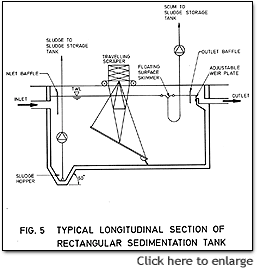 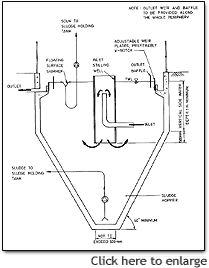
|
| |
|
| 4.23 |
Upward flow sedimentation tanks should be provided with minimum 60o hopper wall slopes to facilitate easy sludge collection and removal. |
| |
|
| 4.24 |
Horizontal flow sedimentation tanks should be provided with a mechanical scraper system on a nominal floor slope, discharging to a sludge hopper. Twin tanks should preferably be used. If single tank is used, the scraper should be of the type that allows the underwater parts to be maintained without the need of shutting down the tank. |
| |
|
| 4.25 |
Adjustable weirs should be used for sedimentation tanks to enable fine levelling.
V-notch weirs should be used where wide flow variation occurs. The side-wall height should be not less than 1 m in order to avoid sludge carryover. The layout should be such that the inlet arrangement never becomes submerged in sludge. |
| |
|
| 4.26 |
A chamber should be provided at the final sedimentation tank outlet after the weir for installation of recirculation pump in the event that the actual initial flow is much lower than the design flow (see 4.1 above). |
| |
|
| 4.27 |
Sludge in sedimentation tanks should be removed as frequently as possible, at least once per day by a suitable sludge withdrawal device such as submersible sludge pumps, airlifts or valves. A scum removal device should also be provided. The sludge and scum removal device should have independent adjustable control. Inspection trough should be provided at the discharge end for inspecting the quality of sludge withdrawn so that adjustment to the withdrawal system may be made accordingly. |
| |
|
| 4.28 |
Chlorination facility should include a flash mixing device followed by a plug flow contact tank. Baffles should be provided in chlorination tanks to prevent short-circuiting. Lateral baffling should be used for shallow tanks and up-and-over baffling should be used for deep tanks. Dechlorination facility may be required in situations where the residual chlorine poses hazard to fisheries or shellfisheries. |
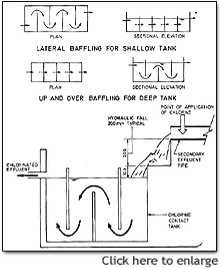 |
| |
|
| 4.29 |
When tertiary treatment is required, disinfection (chlorination, ultra-violet radiation, ozonation, etc.) should be placed after tertiary treatment. |
| |
|
| 4.30 |
Sludge storage tanks should be provided with aerators when they are located in enclosed plant rooms to maintain the aerobic condition of the sludge. However, sludge storage tanks should preferably be ventilated separately to the exterior. Decanting facilities should be fitted to sludge storage tanks. Supernatant should be returned to the equalization tank. |
|
| |
|
| 4.31 |
Sludge pumps should be designed with positive suction head to minimize the possibility of clogging. |
| |
|
| 4.32 |
The diameter of the sludge draw-off pipework should be of a minimum diameter of 80 mm in order to prevent pipe blockages. |
| |
|
| 4.33 |
A sludge dewatering machine capable of attaining 30% w/w dry solids content for landfill disposal and a sludge tank for emergency storage of 14 days sludge volume should be provided. For small STP serving less than 100 population, it may be acceptable to provide only a sludge storage tank for wet disposal provided that:
- a storage tank capable of holding 60 days sludge volume be provided,
- vehicular access is maintained for desludging tankers,
- written confirmation is provided from a desludging contractor undertaking to carry out the work and specifying the ultimate disposal site for the wet sludge.
|
| |
|
| 4.34 |
An automatic flow measuring device with non-resettable type totalizer should be provided at suitable location for measuring the flow for STP serving a population of more than 50. |
| |
|
| 4.35 |
Un punto de muestreo de fácil acceso debe proporcionarse para la toma de muestras del efluente tratado. |
| |
|
| 4.36 |
Una intensidad de iluminación mínima de 300 lux debe proporcionarse en el STP. Las luces deben estar ubicados donde son accesibles para el mantenimiento y reemplazo. |